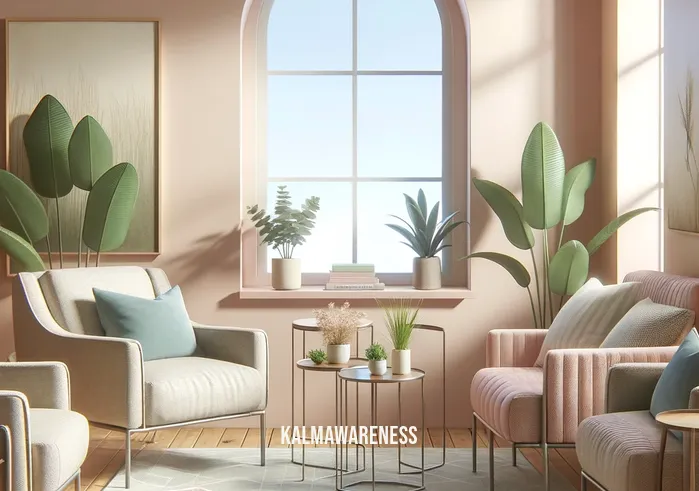The Evolving Landscape of the Therapy Waiting Room: A Sanctuary of Health and Well-being
For many, the mere thought of a therapy waiting room might summon images of sterile spaces with generic chairs, hushed whispers, and a palpable tension in the air. But in today’s era of holistic wellness, these spaces have undergone a revolutionary transformation. They’ve metamorphosed into sanctuaries designed to cultivate health and well-being, even before the therapy session begins. How, you may ask? This segment unfolds the myriad facets of the modern therapy waiting room, setting the stage for an immersive exploration of its components in the segments to follow.
The Significance of a Mindful Ambiance
In the realm of therapeutic environments, the initial impression matters. The waiting room isn’t just a place to sit; it’s an introduction to the healing journey ahead. By integrating principles of mindful movement for sleep, these spaces can actively influence an individual’s mental state. Harnessing the power of ambiance to align with the circadian rhythm, they serve as a precursor to the tranquil experiences one seeks in therapy.
EMDR, Meditation, and Pre-session Grounding
As therapy techniques evolve, the spaces that house them follow suit. Modern therapy waiting rooms often incorporate elements of EMDR meditation, ensuring that the individual is primed for their session. There’s an emerging understanding that grounding oneself, even if through something as unconventional as floating meditation, can significantly enhance the efficacy of the session. The gentle lull of water, or the resonance of binaural beats for migraine, can often be heard, subtly blending into the ambiance.
Mobility and Comfort in Furniture Choices
Gone are the days of the ‘one size fits all’ approach. Today, therapy waiting rooms take inspiration from pieces like the focus side chair, emphasizing mobility and comfort. Recognizing that relaxation can be dynamic, these spaces allow for activities like hand yoga poses or offer guides on how to meditate while lying down. The underlying message? Healing isn’t restricted to the therapist’s chamber; it begins the moment one steps into the waiting room.
The Social Fabric of Healing
Human connection plays a pivotal role in well-being. This understanding has led to the inclusion of community-driven initiatives in therapy waiting rooms. Taking a cue from the sentiment that your feet don’t anchor you, your friends do, these spaces now encourage interaction. Whether it’s through shared experiences, engaging in brene brown’s square squad activities, or simply relishing moments of mutual relaxation using the U-Relax moving techniques, the therapy waiting room fosters a sense of community.
The Promise of an Enriched Experience
Beyond these tangible shifts, the ethos of the therapy waiting room has seen a transformation. The focus is now on creating an environment that involves attaining a peaceful state of mind, devoid of worry. Every element, be it the literature available on managing chronic pain or the serene visual aids promoting mindful breathing, contributes to this mission.
In essence, the therapy waiting room of today serves as a testament to the holistic approach of mental health and well-being. Far from being an afterthought, it stands as a prelude to the healing journey, promising an experience that is nurturing at every step.
Curious about the deeper nuances and the innovations that drive this transformation? Stay with us as we delve into the intricacies of this evolution in the next chapter, weaving together insights, expert opinions, and experiential anecdotes that promise a comprehensive understanding. Continue reading.

The Art and Science Behind Therapy Waiting Rooms: A Detailed Exploration
The modern therapy waiting room is not merely a space but an experience. It’s an orchestrated amalgamation of art and science, with every element carefully chosen to amplify well-being. To comprehend the depth of this transformation, we’ll dive into the elements that make these rooms so impactful, backed by expert insights and statistical evaluations.
Elements That Elevate the Therapy Waiting Room Experience
Functional Design: Gone are the days of cookie-cutter designs. The therapy waiting room now embraces unique, functional designs inspired by concepts like floating meditation. Each piece of furniture, lighting, and layout is strategically chosen to exude calmness and comfort.
Innovative Relaxation Techniques: With advancements in therapeutic approaches, waiting rooms have adopted tools like the mindfulness prescription for adult ADHD. This ensures that individuals of all needs find the solace they seek even before their session begins.
Cultivating Community: Waiting rooms today also focus on community-building. Taking insights from the belief that your feet don’t anchor you, your friends do, these spaces promote interactions, shared experiences, and a sense of belonging.
Personalized Resources: Many waiting rooms now offer resources tailored to individual needs. Whether it’s insights on how to maintain calmness as a kid or techniques to relax and stay aware, these resources cater to a diverse clientele.
Factors Influencing Therapy Waiting Room Choices
To gain a clear understanding of how these spaces are curated, let’s look at a table elucidating the primary factors influencing choices in therapy waiting room designs:
| Factor | Description | Example Resource |
|---|---|---|
| Ambiance & Aesthetics | Crafting a serene environment with the right color palettes, textures, and lightings. | Hand Yoga Poses |
| Functional Furniture | Furniture that’s not just aesthetically pleasing but also serves a therapeutic function. | Focus Side Chair |
| Innovative Techniques | Incorporating latest relaxation and therapeutic techniques in the waiting room experience. | EMDR Meditation |
| Personalized Offerings | Custom resources or guides that address specific needs of visitors. | Managing Emotional Weight |
| Community Building Activities | Activities or setups encouraging interaction and shared experiences. | Brene Brown’s Square Squad |
The Nuances That Matter
Often, it’s the finer details that distinguish a good therapy waiting room from a great one. These rooms, apart from providing immediate relaxation, also set the tone for the therapy ahead. By incorporating elements that allow for a peaceful state of mind, devoid of worries, they ensure that individuals are mentally and emotionally prepared for their sessions. These nuances, from the choice of literature to the ambient sound, play a pivotal role in crafting an enriching experience.
Concluding Thoughts: Preparing for What Lies Ahead
As we’ve seen, the therapy waiting room has undergone significant evolution, becoming an experience in its own right. These spaces, through their careful curation and focus on holistic well-being, set the foundation for impactful therapy sessions.
But, as with all things wellness, there’s always more to explore and understand. In the next chapter, we’ll be unraveling the practical implications of these spaces, exploring real-life stories of transformation, expert opinions, and much more. Ready to dive even deeper? Continue reading and embark on this enlightening journey with us.

Inspirational Journeys: Tales from the Therapy Waiting Room
There’s a quiet strength embedded in the walls of therapy waiting rooms, where countless individuals find the courage to begin their journey towards better mental health. While these spaces are designed to offer solace and comfort, it is the stories that emerge from them which truly inspire. Let’s dive into some real-life accounts that highlight the transformative power of the therapy waiting room and the hope it fosters.
“The First Step Is Always the Hardest”
Sarah, a 28-year-old graphic designer, recalls her experience:
“I still remember the weight in my chest as I stepped into the therapy waiting room for the first time. But as I settled down, the room, with its calming ambiance, reminded me of the mindful movement techniques for sleep I’d read about. That soothing environment was my first brush with healing, making me realize that maybe, just maybe, things would get better.”
This sentiment is echoed by countless others who find unexpected solace in such waiting areas. For many, the waiting room is not just a space to bide time; it’s the prelude to their healing journey.
The Transformative Power of Mindfulness
Miguel, an entrepreneur facing the stressors of a bustling business life, shares:
“Amid the chaos, my anxiety levels skyrocketed. When I decided to seek therapy, the first genuine relief I felt was in the waiting room. I was introduced to techniques like floating meditation and began practicing them then and there. That room was where my mindfulness journey truly began.”
These therapy waiting spaces often seamlessly integrate elements of meditative practices and tranquility. It’s no wonder that many find their initial brush with peace in these rooms.
Discovering Community and Support
Olivia, a college student battling depression, found more than just therapy in that room:
“It was in the therapy waiting room where I met Ana. We’d often find ourselves waiting together and gradually started sharing our stories. The room became our sanctuary, a place where we discovered the strength in having friends who anchor us. Today, we’re each other’s biggest cheerleaders.”
This brings to light another facet of therapy waiting rooms — fostering connections, creating communities, and helping individuals realize they aren’t alone.
The Role of Innovative Therapeutic Techniques
For those like Ravi, a tech professional dealing with chronic pain, the waiting room became a place of learning:
“I’d often reach early for my sessions, giving me time to explore resources in the waiting room. It was here that I stumbled upon tips to take control and live well with chronic pain. These resources weren’t just enlightening; they were transformative.”
Waiting rooms are evolving, and with them, their role in the therapeutic process. By integrating valuable resources and practices like binaural beats for migraines, these spaces offer more than a physical respite — they provide educational gateways.
A Beacon of Hope: The Therapy Waiting Room
The stories shared above underscore a profound truth: therapy waiting rooms are more than just passive spaces. They serve as gateways to hope, healing, and transformation. As the renowned psychologist Brene Brown once said:
“Vulnerability is not winning or losing; it’s having the courage to show up and be seen when we have no control over the outcome.”
For many, the act of showing up begins in the therapy waiting room, a space that subtly reassures and offers a glimpse of the positive change to come.
As we forge ahead, our exploration will pivot to the tangible aspects of therapy waiting rooms — the design, the ambiance, the elements that craft the experience. In the next chapter, delve deeper into the science and artistry that goes into curating these transformative spaces. Continue reading to gain insights into the world behind the waiting room doors.
@
The Anatomy of a Therapy Waiting Room
Therapy waiting rooms, with their subtle ambiance and design, play a significant role in setting the stage for therapeutic sessions. More than just a place to sit, these rooms are crafted with careful consideration, integrating various elements to ensure the comfort and ease of the visitors. Let’s dive deep and break down the crucial components of an effective therapy waiting room.
Essential Elements of a Therapy Waiting Room
Ambiance and Lighting: Soft lighting contributes to a calm environment, helping visitors transition from the outside world to a space of introspection and healing.
Comfortable Seating: As one might infer from resources on how to choose the right side chair, seating is paramount. The seats should provide physical comfort, allowing visitors to relax as they wait.
Soundscaping: Background sounds, such as binaural beats or soft instrumental music, can create a serene environment conducive to mental relaxation.
Reading Material: Offering resources related to mindfulness, such as articles on how to achieve a peaceful state of mind, can be beneficial. Magazines, books, and pamphlets centered on well-being help set the tone for the therapy session.
Mindful Decor: Including decor that promotes relaxation and introspection, like artwork showcasing hand yoga poses, can subtly influence a visitor’s mindset.
The Subtle Impact of Colors
Colors can profoundly influence our mood and perception. Here’s how different colors can impact the atmosphere of a therapy waiting room:
Blue: Often associated with calmness, it can reduce tension and anxiety.
Green: Evokes feelings of tranquility and health, reminiscent of nature and growth.
Soft Yellows: Uplifting and cheerful, yellow can inspire optimism.
Neutral Tones: Beige, soft grays, and whites can give a room a spacious and clean feeling.
The Role of Innovative Therapeutic Tools
Even before stepping into the therapist’s office, individuals can benefit from the innovative tools available in the waiting room:
Interactive Tech: Devices that allow individuals to explore resources on ADHD and mindfulness or dive into EMDR meditation can provide preliminary insights.
Guided Meditation Headsets: For those curious about lying down meditation or other techniques, a guided session can offer a quick mental reset.
Importance of Space Design
The layout of a therapy waiting room is just as important as the elements within:
Open Floor Plans: They can prevent feelings of claustrophobia and provide an expansive feeling.
Private Corners: For those seeking solitude or privacy, having secluded spots can be essential.
Natural Elements: Incorporating plants, water features, or wooden elements can connect individuals to nature, promoting relaxation.
To say a therapy waiting room is just a place to wait would be an understatement. It’s a transitional space, bridging the external world with the intimate conversations of the therapy room. Every element, from the colors on the walls to the reading material on the tables, is curated to offer solace, insight, and comfort.
In our concluding chapter, we’ll reflect upon the transformative journeys that start in these waiting rooms, revisiting their significance and exploring ways to further optimize them for holistic well-being. Join us in the next segment as we tie together the intricate threads of our exploration, offering a holistic view of the profound impact of therapy waiting rooms. Continue reading for our final reflections.
@
Reflections from the Room: The Pivotal Role of Therapy Waiting Rooms
As we draw this enlightening journey to its conclusion, it’s only fitting to pause and reflect upon the myriad insights we’ve gathered. Therapy waiting rooms, far from being mere spaces of transition, emerge as silent allies in an individual’s journey towards mental well-being. The subtle hues on the walls, the serene soundscapes, the mindful decor – every facet plays a role in crafting an atmosphere conducive to healing.
A Sanctuary Before the Session
The undeniable truth is that these spaces function as sanctuaries. Here, individuals are offered a brief respite – a chance to ground themselves before delving into the deeper, often more challenging conversations that await. As explored in our segment on floating meditation, a therapy waiting room can be a realm of tranquility, providing the calm before the transformative storm of the therapy session.
The Harmony of Elements
Just as mindful movement aids sleep, the careful curation of elements within a therapy waiting room can aid in relaxation and introspection. The emotional weight we carry on our shoulders often seeks a reprieve, and these rooms, with their ambient lighting and comforting seating, provide just that.
The Human Connection
Above all, what makes these rooms genuinely special is the connection they foster. In a space where everyone is, in some way, seeking healing, a shared camaraderie often develops. As rightly pointed out in the piece “Your feet don’t anchor you, your friends do”, it’s our shared human experiences that bind us. And therapy waiting rooms become the backdrop for many such fleeting yet meaningful connections.
Looking Ahead with Hope
We’ve embarked on a profound journey, unraveling the nuances of therapy waiting rooms. These spaces, which many may overlook, brim with potential and promise. They stand as testament to the fact that every step of the therapeutic process, even the wait before it truly begins, holds significance.
A Call to Further Exploration: For those curious souls yearning to delve deeper, we invite you to explore more topics of mindfulness and well-being peppered throughout our magazine. Whether you’re keen on understanding how to relax and be aware or are intrigued by the art of mindful breathing, there’s a treasure trove awaiting your discovery.
A Token of Gratitude: To our cherished readers, thank you for embarking on this journey with us. Your curiosity and thirst for knowledge drive us to craft content that not only informs but also inspires. Stay tuned for more insightful explorations in our upcoming editions.
In the vast realm of mental well-being, there’s always more to learn, more to discover. We hope this exploration of therapy waiting rooms has sparked an interest, urging you to notice and appreciate the smaller details in your surroundings. Until next time, stay curious, stay inspired, and always remember the power of spaces in shaping our experiences.




